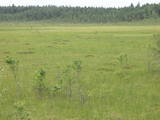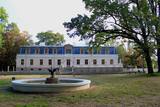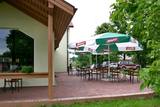| Нo | Название | Описание |
|---|---|---|
|
Маршрут ведет вдоль обоих берегов судьбоносной реки латышей – Даугавы. В маршрут включены такие значимые места, как развалины Кокнесского замка и создаваемый «Сад Судьбы». Путешественников порадуют как чудесные виды на речные ландшафты, так и древние городища, латгальские гончарные традиции и другие мастера ремесел. Даугавпилс с предложением многообразного военно-индустриального наследия и художественным центром знаменитого художника Марка Ротко. Информация о маршруте от Latvijas Lauku forums |
||
|
Завод шмаковки Малнавской усадьбы (1827) предлагает посетителям экскурсию, дегустацию, закуски. Осмотр усадьбы, парка, бункеров Гитлера, туристическая информация о достопримечательностях Латгалии. |
||
|
Tūrisma gide Ineta Jansone piedāvā ekskursijas grupām uz Ķemeriem un iepazīstina ar Ķemeru kūrorta vēsturi. Kopš seniem laikiem Ķemeri slaveni ar to, ka šeit ir daudz sērūdeņu avotu un ārstnieciskās dūņas. Šurp brauca ārstēties kopš 19. gs. sākuma. 1838. gadā Ķemeros nodibināja kūrortu. Ķemeru kūrortā ārstēja ādas un kaulu slimības, kā arī gremošanas un nervu sistēmas slimības. 1877.g. izbūvēja dzelzceļa līniju Rīga - Tukums, bet 20.gs. sākumā tika ieviesta tiešā dzelzceļa satiksme ar Maskavu. Kūrorts bija ļoti populārs un katru gadu arvien vairāk viesu brauca šurp ārstēties. Īsi pirms I Pasaules kara atklāja elektriskā tramvaja satiksmi starp Ķemeriem un jūru - Jaunķemeriem. Ķemeri atrodas starp purviem un ezeriem, 6 km attālumā no Rīgas jūras līča. |
||
|
Dabas liegums veidots salīdzinoši neliela pārejas tipa purva aizsardzībai. Purvu lieliski var pārredzēt no nelielā skatu torņa.
|
||
|
Жагаре с давних пор славится особым сортом вишен «Žagarvyšnė» («Жагарская вишня»). Существует несколько разновидностей этого сорта, которые различаются по времени созревания, урожайности, форме деревьев и другим признакам. Эти вишни и сейчас растут почти в каждом местном саду, став уникальным символом поселка Жагаре. |
||
|
"Gusts Apinis" is located in Vidzeme highlands, Amata region. The company is unique in that it grows non-traditional crops in Latvia: quinoa, amaranth, millet, lentils, etc. Produces flour and pasta (buckwheat, buckwheat-quinoa) from grown products. |
||
|
The smoke sauna is an important part of everyday life in the Võru community in Estonia. It is the centre of a rich set of traditions including the actual bathing customs, the skills of making bathing whisks, building and repairing saunas, and smoking meat in the sauna. The sauna is a building or room heated by a stove covered with stones and with an elevated platform for sitting or lying. It has no chimney, and the smoke from the burning wood circulates in the room. People usually go into the sauna together and remain until they are sweating. Water is thrown on the heated stones to produce hot steam-laden air and bathers beat their bodies with whisks to remove dead skin and stimulate blood circulation. After sweating, whisking, relaxing and possible healing procedures, people cool themselves outside and rinse their bodies with water. The procedure is then repeated. The smoke sauna tradition is primarily a family custom, usually practised on Saturdays, but also before major festivals or family events. Its main function is to relax the body and mind. Families take turns hosting each other. Usually an older family member is responsible for preparing the sauna, accompanied by the children who gradually acquire the necessary skills. The smoke sauna tradition is part of the UNESCO Representative List of the Intangible Cultural Heritage of Humanity. |
||
|
Маршрут подходит для тех, кто любит наслаждаться природными и культурными ценностями! Сказочные Слитерские Синие горы известны уже с давних времен, когда на них «пираты» жгли ложные костры, чтобы корабли налетали на мель мыса Колки. В наше время берега национального парка «Слитере» образно наывают геологическим музеем Балтийского моря под открытым небом, так как здесь можно увидеть древний берег Балтийского ледникового озера, береговой уступ Анцильского озера и дюнные образования Литоринского моря (валообразные дюны (кангари) и заболоченные междюновые впадины (виги)), которые наглядно отображают историю развития Балтийского моря за последние 10 000 лет. Этот берег исторически населяли ливы, рыбацкие поселки которых являются значимой культурной средой одного из самых малых национальных меньшинств в мире. Маршрут на участке от Мазирбе до Колки ведет по старой прибрежной дороге, которая петляет через ливские поселки – Кошрагс, Питрагс, Саунагс и Вайде. Национальный парк «Слитере» – одна из наиболее флорестически богатых территорий Латвии, а мыс Колка – одно из популярнейших мест для наблюдения за птицами во время их миграции. Информация о маршруте от Latvijas Lauku forums |
||
|
В большом загоне, который доступен для детей и их родителей в качестве знакомства с живой природой, пасутся козы, свиньи, домашние птицы и другие животные. Можно понаблюдать за кроликами. В сезон предлагаются яйца домашних птиц. |
||
|
Radošajā mājā Latvietes pūrs var apgūt praktiskās iemaņas rokdarbu veidos, kas nepieciesami latviešu tautas tērpu darināšanai – baltie un krāsainie darbi, zīļu vainagu darināšana, adīšana, tamborēšana, tilla izšuvumi, pīto un austo jostu darināšana u.c. Saimniece pati pārzina dažādus rokdarbu veidus un to tehnikas, nepieciešamības gadījumā tiek pieaicināti sava aroda meistari. Ir zināšanas par latviešu tautas tērpa novadu īpatnībām, saimniece labi zina tautas tērpu attīstības vēsturi un pielietojumu
|
||
|
Piedāvā ļoti gardus Lietuviešu tradicionālos ēdienus. Var pieņemt līdz 1000 personām.Pieņem bankas kartes, ir āra terase, dzīvā mūzika kā arī autostāvvieta. |
||
|
Здание железнодорожной станции "Кемери" –
первое здание станции было построено еще в 1877 году в
связи с открытием железной дороги. Одно время сюда
прибывал поезд Москва – Кемери, а до 1920 г. от станции
до пляжа Яункемери курсировал трамвай. Разрушенное
во время Первой мировой войны здание
железнодорожного вокзала повторно отстроили в 1922 г.
(архитектор А. Медлингер). В свое время это было первое
строение, возведенное в Кемери во время первого
свободного Латвийского государства. Здание станции
перестраивалось еще раз после Второй мировой войны. В
помещении станции находится Кемерский пункт проката
велосипедов.
|
||
|
Находятся на обочине старинной дороги Ливония – Пруссия, сегодня – ул. Лиепаяс. Символ Айзпуте, изображенный на гербе и флаге города. Строительство замка в Айзпуте было начато в 1248 г.(существует разные версии) во времена ландмейстераДитриха фон Гренингена.Строился как каменный замок типа костела с угловой башней и деревянными постройками во дворе. В средние века в Айзпуте находился центр Курземской епископии. После Ливонской войны, во второй половине XVI века, замок не использовался, а в начале XVII века его восстановили, возводя пристройки.С промежутками в замке жили вплоть до 70 годов прошлого столетия, когда в одной его части находились квартиры. Развалины частично законсервированы, и взбираться на развалины запрещено и опасно. Айзпуте – один из старейших городов Латвии, и первые упоминания о нем относятся к 1378 году. В 100 м на востоке от развалин находится каменный мост через Тебру – один из новейших построенных в Латвии каменных мостов. Каменные перила моста – это подарок барона Карла фон Мантейфеля Айзпуте (построен в 1907 году). В перила с северной стороны вмурована гранитная пластина с гербом рода Мантейфелей, который уже слабо различим. |
||
|
Выдается в виде внушительной рельефной формы (15 м) на правом берегу реки Резекне. В 9 - 12 вв. здесь располагался замок древних латгальцев, на месте которого в 1285 г. Ливонский орден приступил к строительству двухэтажного каменного замка. До наших дней в городище сохранились небольшие развалины замка . Рядом с городищем находится Центр творческих услуг Восточной Латвии - „Zeimuļs” и Информационный Туристический Центр. |
||
|
Расположен на самом берегу моря, с двумя террасами и всеохватывающим видом на Юрмалу. Латышская кухня: Маринованная селедка с творогом, картофельные блины, жареная балтийская камбала, каре барашка, латвийские сыры. |
||
|
Фонд музея (основан в 1954 г.) отображает традиции латышских и ливских рыбаков, моряков и крестьян, их среду и образ жизни. В экспозиции музея под открытым небом представлены рыбацкие дворы с будками для сетей, коптильнями и дымовыми, клетями и др. Здесь размещена коллекция рыбацких лодок и самая большая в Балтии коллекция якорей (> 100 экземпляров, крупнейший весит 22 т). Из волости Ужавас привезена ветряная мельница. В жилом доме «Смилтниеки», построенном в 19 веке, представлены к осмотру аутентичные предметы быта. Популярность завоевала поездка (с 1 мая по 31 октября) на маленьком паровозике «мазбанитис» (ширина рельсов 600 мм) по линии Кална, протяженностью 1,3 км, в конце которой находится кольцевая. Здание музея построено по образцу бывшей железнодорожной станции «Мазирбе». Часть музея входит в Приморский парк (детские игровые площадки и тропа Якорей). |
||
|
Расположено в центре Дундаги – в гостевом доме «Крузини». Латышская кухня: Суп из кислой капусты, серый горох с простоквашей, жареная камбала или треска, суп из кислой капусты с картошкой. Особое блюдо: «Творожная башенка» или крем из продуктов Дундагского молокозавода. |
||
|
Viens no diviem nacionālā parka skatu torņiem, kas atrodas ~ 1,5 km ziemeļos no Ehijerva ezera (Ähijärv). Tornis ir veiksmīgi „nomaskēts” nelielā priežu pudurī, tādēļ tas „nebojā” izcilo dabas un kultūrainavu, kas paveras no tā skatu platformas. Pie autostāvlaukuma ir izveidota labiekārtota atpūtas vieta. |
||
|
Ja Rušona ezeru iepazīstiet ar laivu, tad var apmeklēt Lielo salu (ezera rietumdaļā),kur (augstākajā vietā) ir jāuzmeklē ap 1,2 m augstais akmens. Konstatēts, ka tā apkārtnē un uz virsmas kurināta uguns. Atrastas arī senlietas. Nostāsti vēsta, ka akmens virsmā bijušas iekaltas zīmes (nav saskatāmas) un pie tā upurēti jēri. Tikai nedodieties ezerā, ja ir vai gaidāms stiprs vējš! Rušona ezera salas ir dabas liegums. |
||
|
Находится в центре Лизума. Предлагают особые блюда края. В интерьере использованы латышские знаки. Латышская кухня: Холодный суп, суп с фрикадельками, охотничьи колбаски. |
||























